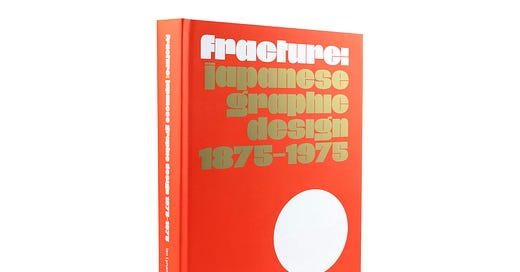How Ian Lynam wrote a history of Japanese Graphic Design
A few questions for the designer and writer about his monumental new book on Japanese graphic design history.
Ian Lynam’s (episode 39) productivity never ceases to amaze me. Alongside teaching the Temple University Japan, operating his design studio, and the retail shop Sailosaibin, he’s somehow also found time to release three books over the last few years (The Failed Painter, War With Myself, and The Impossibility of Silence). In between all of this, for the last fifteen years, he’s also been working on a book of Japanese design history. That book became Fracture: Japanese Graphic Design History 1875-1975, out now from Set Margins Press.
Lynam moved to Japan twenty years ago. “I wasn’t sure if I was going to stay. I kept finding cool stuff that was very interesting to observe,” he told me. “A lot of things happened in my life and I decided to stay here and make a life here… to literally jettison the notion of return.” While he had an education in design history, his understanding of design in Japan was limited. He started reading, then saving images, then writing bits of biographies. Over time, this history book emerged. It’s a monumental achievement, a book that will demystify how we understand graphic design in Japan. I asked Ian some questions about the book and his process.
You’ve taught in graphic design programs in Japan for almost two decades. How is graphic design history taught in Japan and what is Japan’s own relationship to “Japanese graphic design”?
It’s interesting, as graphic design history in Japan is largely not taught—at least in the sense of survey courses. Kiyonori Muroga, former editor-in-chief of Idea magazine, teaches part-time at Tokyo University of Fine Art and he brings in historical slices to talk about design theories and methodologies in his classes, but most other schools shy away from overarching histories.
I think that a big part of it is that there is so much literature about specific designers in Japan and there is only one really thin book that might be used as a survey text of Japanese graphic design history. I think that when you are part of a society and there is that much cultural output, it is incredibly daunting to try to construct a greater timeline.
I am currently working with a Japanese publisher on putting out the Japanese version of my book—hopefully that will nudge things a bit.
Tell me more about the title and this concept of “fracture”. You write “Japan is a nation which took over large parts of Asia, lost it all, and has since turned inward, both pondering and shouting its schizophrenic place in history both quietly and aloud.” How has this, do you think, influenced Japanese graphic design?
Japan literally had an empire that was disassembled as one of the outcomes of World War 2. This notion of Empire is kaleidoscopic in its reach. There is immense resentment in South Korea and China to the ways in which its people were subjugated, whereas in Taiwan occupation brought about a lot of infrastructure and is viewed more kindly. In Japan itself, there are a dizzying number of perspectives—from anti-war pacifism to self-righteous calls to the restoration of the Emperor to power by ultra/conservatives. You can literally see the reactions in much graphic design created by Yokoo Tadanori, Fukuda Shigeo, Hara Hiromu, and many others.





